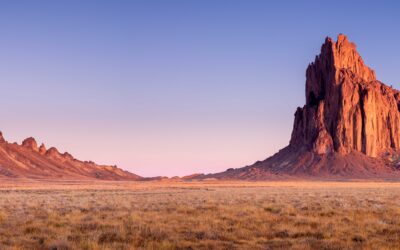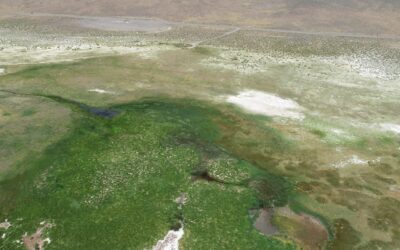Baylor University paleoclimatologist analyzed gypsum- and quartz-dominated dune systems for possible fine, breathable dust fluxes detrimental to human health
Above: Mark Sweeney and Eric McDonald set up measurements of PI-SWERL at White Sands National Park. Credit: Baylor University.
Reportsed from Baylor University: https://www.baylor.edu/mediacommunications/news.php?action=story&story=226267
WACO, Texas – A recent National Science Foundation funded study that included Baylor University paleoclimatologist Steven L. Forman, Ph.D., professor of geosciences, evaluates current and future dust sources in central North America with consideration for climate change. These fine dust fluxes are detrimental to asthmatic and general cardio-pulmonary health for populations downwind, particularly areas of west Texas and New Mexico that have large areas of significant dust sources with dry and drought conditions in the past decade.
The study, published in Geology, seeks to characterize dust emission potential from landforms in two end-member eolian systems, where wind is the primary source of sediment transport: the White Sands dune field in New Mexico and the Monahans dune field in west Texas. The study’s lead author is Mark Sweeney, Ph.D., University of South Dakota. Eric McDonald, Desert Research Institute, joined Sweeney and Forman on the research team.
The White Sands dune field is composed of gypsum and a hot spot for dust emissions because the dunes and adjacent playa yield high dust fluxes. However, the active Monahans dune field is composed of quartz and produce low dust fluxes. Adjacent to Monahans, stabilized sand sheets and dunes that contain silt and clay could produce high dust fluxes if reactivated by climate change or anthropogenic disturbance.
“We chose these sites because the gypsum dunes and playa lake environments should be hot spots for dust emission, and the Monahans composed of mostly pure quartz grains should be a low dust emission system. We were wrong about the Monahans,” Forman said.
Field- and model-based estimates of dust emissions from dune systems are difficult to characterize. By considering whole eolian systems — active and stabilized dunes, interdunes, sand sheets and playas — dust emissions can be more accurately estimated for estimating current and future atmospheric dust loading. Atmospheric dust has impacts on radiative forcing, biogeochemical cycles, extreme climate variability and human health.
The researchers utilized a Portable In Situ Wind Erosion Laboratory (PI-SWERL) to measure the dust emission potential in the field. The PI-SWERL, which was developed by a team from DRI, is a circular wind-erosion device, measures concentrations of inhalant particulate matter at different friction velocities from soil surfaces.
“The PI-SWERL is wind tunnel wrapped into a circle which makes this novel technology portable,” Forman said. “Thus, we can quantify the winds speeds and forces necessary to loft small, breathable particle sizes that at certain elevated concentrations induce an asthmatic response and heightened risk of pulmonary mortality and morbidity.”
The PI-SWERL measurements showed considerable differences in the dust emission potential across both systems. Active dunes, sand sheets and interdunes at White Sands generated similarly high dust fluxes. Comparatively, the playa had the widest range of fluxes with the lowest fluxes on moist or hard surfaces and the highest where loose sand and aggregates were at the surface.
In contrast, the Monahans active quartz dunes generated low dust fluxes. However, dry crusted interdunes with loose sand at the surface had much higher fluxes. Dust emissions increase exponentially with rising wind friction velocities for both systems, often associated with common winds 10 to 15 mph.
The results revealed intra- and extra-landform variability in dust fluxes from eolian systems, mostly due to the degree of surface crusting or soil moisture. More dust occurs on surfaces with loose sand or aggregates where saltation bombardment, when wind lifts particles and causes them to hit along the surface with increased velocity, could erode playas or interdunes and aggregates could break apart to create more dust.
Surprisingly, White Sands showed high magnitudes of dust emission from the abrasion of dune sand and erosion of playa sediments, indicating both landforms are particulate sources during dust storms. The Monahans system produced low dust emissions due to low rates of abrasion in active dunes and vegetative cover, which protects the surface from wind erosion. However, the most common landforms — sand sheets that surround the dune fields for miles — are rich sources for fine breathable particles, at the same magnitude as White Sands.
“The most surprising results was variability in dust emissivity for White Sands landforms and the very high dust flux from the flat sand sheet area that covers most surfaces in west Texas. There is a hidden dust source in these deposits and soils, which were unrecognized,” Forman said.
Dust emission assessments are important to current and future climate modeling. Wind-dominated and drought-sensitive systems could see stabilized dunes and sand sheets become reactivated, or adjacent playas may increase emissions. Potential atmospheric dust loading can occur from diverse landforms in active and presently stabilized eolian systems.
“Atmospheric dust concentrations are important for the global heat-balance and locally can lead to a thermal-blanking effect raising local temperatures. Recent studies associate ozone degradation with elevated dust concentrations high in the atmosphere,” Forman said. “As our planet warms from increasing greenhouse gases many deserts will expand, and grassland areas like on the Southern High Plains will diminish, revealing a limitless supply of dust that will worsen aridity and is detrimental to human health. Understanding the land surface response to climate warming is critical for future sustainability.”
###
About Baylor University
Baylor University is a private Christian University and a nationally ranked Research 1 institution. The University provides a vibrant campus community for more than 20,000 students by blending interdisciplinary research with an international reputation for educational excellence and a faculty commitment to teaching and scholarship. Chartered in 1845 by the Republic of Texas through the efforts of Baptist pioneers, Baylor is the oldest continually operating University in Texas. Located in Waco, Baylor welcomes students from all 50 states and more than 90 countries to study a broad range of degrees among its 12 nationally recognized academic divisions.
About DRI
The Desert Research Institute (DRI) is a recognized world leader in basic and applied environmental research. Committed to scientific excellence and integrity, DRI faculty, students who work alongside them, and staff have developed scientific knowledge and innovative technologies in research projects around the globe. Since 1959, DRI’s research has advanced scientific knowledge on topics ranging from humans’ impact on the environment to the environment’s impact on humans. DRI’s impactful science and inspiring solutions support Nevada’s diverse economy, provide science-based educational opportunities, and inform policymakers, business leaders, and community members. With campuses in Las Vegas and Reno, DRI serves as the non-profit research arm of the Nevada System of Higher Education. For more information, please visit www.dri.edu.


